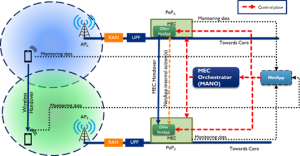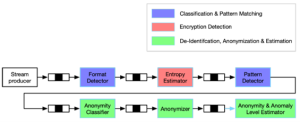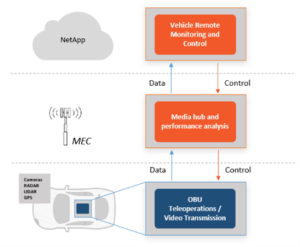BDFI academic Dr Xenofon Vasilakos recently attended the IEEE ICC 2023 Industry Forum and Exhibition in Rome where he gave a speech to the IF&E workshop. In this blog he goes into detail about the topics covered in the speech, as we move from the fifth (5G) towards to the sixth (6G) generation of telecommunication networks.
5GASP explores self-managing and self-organizing automation for the development of sixth generation (6G) intelligent future networks. This is achieved through an ecosystem of specialized AI-driven network applications that enable automation. These applications fulfil the automation requirements of other “enhanced” network applications or services. The prototypes of these applications include network and performance prediction systems that enable proactive resource management and a human-centric approach, adapting to the dynamic nature of 6G networks and users without the need for human intervention. This AI-based automation provides improved network and service quality, while also ensuring compliance with business requirements and enhancing service agility.
Below, we provide a summary of the prototypes for AI-driven enablers, self-organised, or managed network applications.
(1) Efficient MEC Handover (EMHO) network application (Univ. of Bristol, AI-driven Autonomy enabler)
 The functioning of this network application depends on collaborative machine learning (ML) predictions to maintain and potentially improve the quality of service provided by enhanced network applications operating on a multi-access edge computing (MEC) platform. The existing prototype utilizes mobile radio resource control (RRC) monitoring data along with an additional ML layer consisting of cooperative models that predict MEC handovers.
The functioning of this network application depends on collaborative machine learning (ML) predictions to maintain and potentially improve the quality of service provided by enhanced network applications operating on a multi-access edge computing (MEC) platform. The existing prototype utilizes mobile radio resource control (RRC) monitoring data along with an additional ML layer consisting of cooperative models that predict MEC handovers.
(2) Virtual On-Board Unit (vOBU) provisioning Network Application (OdinS, AI self-organisation)
 This network application deploys a digital twin (DT) of a car on-board unit (OBU) on the nearest MEC node of its location. The DT can be “migrated” to car’s nearest edge as a twin (virtual) vOBU acting as a proxy, and its migration automatically begins upon cars’ movement. To avoid bottlenecks, this network application can pose an intent for forecasting future car locations with EMHO’s mobility prediction ML, thus allowing it to proactively deploy vOBU.
This network application deploys a digital twin (DT) of a car on-board unit (OBU) on the nearest MEC node of its location. The DT can be “migrated” to car’s nearest edge as a twin (virtual) vOBU acting as a proxy, and its migration automatically begins upon cars’ movement. To avoid bottlenecks, this network application can pose an intent for forecasting future car locations with EMHO’s mobility prediction ML, thus allowing it to proactively deploy vOBU.
(3) PrivacyAnalyser Network Application (Lamda Networks, self-management)
 PrivacyAnalyser is a cross-vertical cloud-native application running either at network Core or MEC. Among other features, it caters for ML network data classification from UE and/or IoT devices, and privacy evaluation and analysis. Also, PrivacyAnalyser is converging toward ML-based network management and orchestration via EMHO’s exposed ML predictions, enabling smart scale-in/out MEC pods proactively, better than the default container autoscaling for improving energy efficiency.
PrivacyAnalyser is a cross-vertical cloud-native application running either at network Core or MEC. Among other features, it caters for ML network data classification from UE and/or IoT devices, and privacy evaluation and analysis. Also, PrivacyAnalyser is converging toward ML-based network management and orchestration via EMHO’s exposed ML predictions, enabling smart scale-in/out MEC pods proactively, better than the default container autoscaling for improving energy efficiency.
(4) Remote Human Driving Network Application (DriveU.auto, AI-driven self-management & self-organisation)
 This Network Application enables remote autonomous vehicle operation in unusual/dangerous situations. The intent is to ensure reliable, low-latency, high-quality real-time video transmission via AI-optimised network latency, but also via EMHO Network Application handover predictions to automatically deploy appropriate applications with optimised slice features matching dynamic needs.
This Network Application enables remote autonomous vehicle operation in unusual/dangerous situations. The intent is to ensure reliable, low-latency, high-quality real-time video transmission via AI-optimised network latency, but also via EMHO Network Application handover predictions to automatically deploy appropriate applications with optimised slice features matching dynamic needs.
Future Steps, Impact & sociotechnical aspects
5GASP aims to establish an Open Source Software (OSS) repository and a VNF marketplace that caters to small and medium-sized enterprises (SMEs). It also focuses on fostering a community of network application developers by providing them with tools and services. These resources enable developers to achieve the following goals: (i) implement AI-driven network automation in network applications to improve network quality with minimal human intervention by capturing business and other intents through continuous monitoring, (ii) validate and certify network services early on to ensure alignment with business and other sociotechnical goals, and (iii) prioritize inter-domain use-cases for daily testing, validation, and ensuring security and trust of third-party intellectual property rights (IPR) in their testbeds.
The key lessons learned so far can be summarized as follows:
- AI-driven automation plays a vital role in enhancing network and service automation by minimizing the need for human intervention and improving quality of service (QoS). Moreover, it allows the adoption of higher-level policies through proper orchestration decisions. Therefore, several sociotechnical aspects can be captured by translating key value indicators (KVIs) to network performance KPIs targets for AI enabler applications.
- AI-driven network applications and the consumption of AI-driven artefacts (such as predictions or dynamic network orchestration suggestions) make 6G network automation achievable. Again, this can enable the adoption/imposition of sociotechnical targets and policies.
As for the next steps, the project has achieved a level of maturity where network applications are already deployed using the developed tools and procedures. The project is currently seeking network application developers, individuals or SMEs, outside of the consortium who are interested in validating their 5G applications and adopting the 5GASP methodology, tools, and innovative 6G automation network applications.
Related work
[1] A. Bonea et. al, Automated onboarding, testing and validation for Network Applications and Verticals, ISSCS Iasi, 2021.
[2] Kostis Trantzas et al., An automated CI/CD process for testing and deployment of Network Applications over 5G infrastructure, IEEE International Mediterranean Conference on Communications and Networking, 7–10 September 2021.
[3] X. Vasilakos et al., Towards Low-latent & Load-balanced VNF Placement with Hierarchical Reinforcement Learning, IEEE International Mediterranean Conference on Communications and Networking, 7–10 September 2021.
[4] M. Bunyakitanon et al., HELICON: Orchestrating low-latent & load-balanced Virtual Network Functions, IEEE ICC 2022.
[5] V. A. Siris et al. Exploiting mobility prediction for mobility & popularity caching and DASH adaptation, IEEE 17th International Symposium on A World of Wireless, Mobile and Multimedia Networks, 2016.
[6] R. Direito, et al., Towards a Fully Automated System for Testing and Validating Network Applications, NetSoft 2022, 2022.
[7] X. Vasilakos et al., Towards an intelligent 6G architecture: the case of jointly Optimised handover and Orchestration, WWRF47, 2022.
[8] N. Uniyal et al., On the design of a native Zero-touch 6G architecture, WWRF47, 2022.

